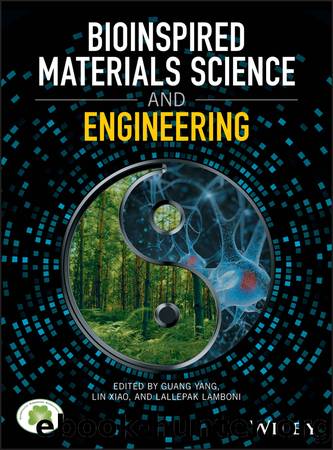Bioinspired Materials Science and Engineering by Guang Yang & Lin Xiao & Lallepak Lamboni

Author:Guang Yang & Lin Xiao & Lallepak Lamboni [Guang Yang]
Language: eng
Format: epub
Publisher: Wiley
Published: 2018-08-20T16:00:00+00:00
8.2.2 Structural Aspects of Seed Polysaccharides Affecting Configuration and Macroscopic Properties
The presence of different substitutions along the polymeric backbone (e.g. neutral sugars, uronic acids, and chemical modifications such as acetylation) of seed polysaccharides, their pattern of substitution, and molecular weight determine the macroscopic properties of seed polysaccharides. These structural effects are complex and sometimes even conflicting. An early review [127] pointed out the role of the substituents in complex polysaccharides in altering the inter‐ and intramolecular hydrogen bonding networks and the water interaction. This in turn influences the macromolecular conformation in solution, including the ability to form ordered structures (e.g. helices) by cooperative interactions, the stiffness of the molecular chains and finally the (in)solubility/aggregative behavior in the specific solvent. Finally, the macroscopic properties in both solution and the solid state, including viscosity, gel forming, rheology and viscoelasticity, crystallinity, film forming, barrier properties, and mechanical properties are largely influenced by these structural features. It is therefore fundamental to assess thoroughly the molecular structure of the polysaccharides to understand and control the final macroscopic properties of the derived materials.
A good example to understand the effect of the glycosyl substitutions on the macromolecular conformation and the solution properties in water of seed polysaccharides is the case of seed galactomannans with different ratios of galactosyl substitutions (M:G ratios). Molecular dynamic studies of galactomannans, from a purely linear mannan to galactomannans with increasing Gal substitutions (M:G from 5:1 to 1:1) pointed out the influence of substitutions in chain flexibility [128]. Computational studies were used to predict spatial characteristics of the (galacto)mannan chains, including the persistence length, which is a mechanical property related to the stiffness of a polymeric chain. Linear mannan exhibits a rigid backbone chain with an estimated persistence length of 14 nm, which is progressively reduced by the addition of Gal side chains. This influence of side substitutions of chain flexibility reaches a plateau for high levels of substitution (between 3:1 to 1:1), with estimated values of persistence length of 9 nm. In these cases, it is the substitution pattern rather than the content of substitutions that plays a major role. These observations are in agreement with the experimental values obtained for tara, locust bean and guar gum obtained by multiple‐detection size‐exclusion chromatography, differential viscometry, light scattering, and sedimentation studies [129–132].
Multiple‐detection size‐exclusion chromatography (SEC) is a very powerful technique to investigate the influence of fine structural details on the conformational properties of seed polysaccharides. The combined use of multi‐angle laser light scattering (MALLS) and a concentration detector (typically differential refractometry for polysaccharides) hyphenated to SEC provides both the size dependence of the absolute weight‐average molecular weight () and the root‐mean‐square z‐average radius of gyration Rg,z, given the known values of the differential refractive index increment (dn/dc) for the polysaccharide in the specific solvent and temperature of separation [133]. The direct representation of molecular weight versus macromolecular size, also known as a conformational plot, offers a robust estimation of the conformation of the polysaccharides in solution. This dependence is well described by a simple power equation
Download
This site does not store any files on its server. We only index and link to content provided by other sites. Please contact the content providers to delete copyright contents if any and email us, we'll remove relevant links or contents immediately.
| Automotive | Engineering |
| Transportation |
Whiskies Galore by Ian Buxton(41541)
Introduction to Aircraft Design (Cambridge Aerospace Series) by John P. Fielding(32893)
Small Unmanned Fixed-wing Aircraft Design by Andrew J. Keane Andras Sobester James P. Scanlan & András Sóbester & James P. Scanlan(32581)
Craft Beer for the Homebrewer by Michael Agnew(17938)
Turbulence by E. J. Noyes(7718)
The Complete Stick Figure Physics Tutorials by Allen Sarah(7151)
Kaplan MCAT General Chemistry Review by Kaplan(6606)
The Thirst by Nesbo Jo(6451)
Bad Blood by John Carreyrou(6286)
Modelling of Convective Heat and Mass Transfer in Rotating Flows by Igor V. Shevchuk(6231)
Learning SQL by Alan Beaulieu(6043)
Weapons of Math Destruction by Cathy O'Neil(5853)
Man-made Catastrophes and Risk Information Concealment by Dmitry Chernov & Didier Sornette(5673)
Digital Minimalism by Cal Newport;(5397)
Life 3.0: Being Human in the Age of Artificial Intelligence by Tegmark Max(5198)
iGen by Jean M. Twenge(5170)
Secrets of Antigravity Propulsion: Tesla, UFOs, and Classified Aerospace Technology by Ph.D. Paul A. Laviolette(5013)
Design of Trajectory Optimization Approach for Space Maneuver Vehicle Skip Entry Problems by Runqi Chai & Al Savvaris & Antonios Tsourdos & Senchun Chai(4849)
Electronic Devices & Circuits by Jacob Millman & Christos C. Halkias(4757)
